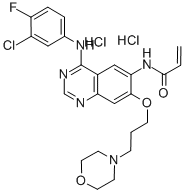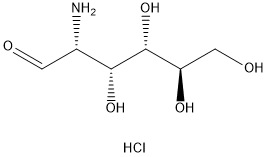Canertinib dihydrochloride
Synonym(s):Canertinib dihydrochloride;N-[4-(3-Chloro-4-fluorophenylamino)-7-(3-morpholin-4-ylpropoxy)quinazolin-6-yl]acrylamide dihydrochloride;N-[4-[(3-Chloro-4-fluorophenyl)amino]-7-[3-(4-morpholinyl)propoxy]-6-quinazolinyl]-2-propenamide dihydrochloride;PD183805
- CAS NO.:289499-45-2
- Empirical Formula: C24H27Cl3FN5O3
- Molecular Weight: 558.86
- MDL number: MFCD09954112
- SAFETY DATA SHEET (SDS)
- Update Date: 2024-11-19 15:53:33

What is Canertinib dihydrochloride?
The Uses of Canertinib dihydrochloride
The HER family of receptor tyrosine kinases, EGFR, HER2, HER3, and HER4, mediate proliferation, migration, adhesion, differentiation, and survival in many different cell types and have been implicated in the development and progression of a variety of human tumors.Canertinib dihydrochloride is an irreversible quinazoline-based HER family tyrosine kinase inhibitor with IC50 values of 0.8, 19, and 7 nM for blocking in vitro activity of EGFR, HER2, and HER4, respectively. As a broadly applicable anti-cancer agent, it has been used to suppress proliferation of malignant peripheral nerve sheath tumor cells (effective concentration of 250-500 nM), to inhibit growth and induce dose-dependent apoptosis in a panel of neuroblastoma cell lines (IC50s = 0.94-2.45 μM), and to reduce proliferation of acute myeloid leukemia cells (IC50 = 0.27 μM). Canertinib dihydrochloride also displays anti-neoplastic activity towards T98G glioblastoma cells, HCT8 colorectal carcinoma cells, and cells expressing the breast cancer resistance protein.
The Uses of Canertinib dihydrochloride
CI-1033 is a potent inhibitor of EGFR and ErbB2 with IC50 of 1.5 nM and 9.0 nM, respectively.
The Uses of Canertinib dihydrochloride
Canertinib Dihydrochloride is a water-soluble, EGFR, HER2, and ErbB-4 tyrosine kinase inhibitor.
What are the applications of Application
Canertinib Dihydrochloride is a water-soluble, EGFR, HER2, and ErbB-4 tyrosine kinase inhibitor
storage
Store at -20°C
Properties of Canertinib dihydrochloride
| storage temp. | Sealed in dry,Store in freezer, under -20°C |
| solubility | DMSO: >10mg/mL |
| form | solid |
| color | Light yellow to green yellow |
Safety information for Canertinib dihydrochloride
| Signal word | Warning |
| Pictogram(s) |
 Exclamation Mark Irritant GHS07 |
| GHS Hazard Statements |
H315:Skin corrosion/irritation H319:Serious eye damage/eye irritation H335:Specific target organ toxicity, single exposure;Respiratory tract irritation |
| Precautionary Statement Codes |
P261:Avoid breathing dust/fume/gas/mist/vapours/spray. P305+P351+P338:IF IN EYES: Rinse cautiously with water for several minutes. Remove contact lenses, if present and easy to do. Continuerinsing. |
Computed Descriptors for Canertinib dihydrochloride
New Products
4-AMINO-TETRAHYDRO-PYRAN-4-CARBOXYLIC ACID HCL 4-(Dimethylamino)tetrahydro-2H-pyran-4-carbonitrile 4-AMINO-TETRAHYDRO-PYRAN-4-CARBOXYLIC ACID 4-Aminotetrahydropyran-4-carbonitrile Hydrochloride (R)-3-Aminobutanenitrile Hydrochloride 5-Bromo-2-nitropyridine Nimesulide BP Aceclofenac IP/BP/EP Diclofenac Sodium IP/BP/EP/USP Mefenamic Acid IP/BP/EP/USP Ornidazole IP Diclofenac Potassium 3-Bromopyrazole (3aR,4R,5R,6aS)-hexahydro-5-Triethyl silyloxy-4-((E)-3-oxo-5-phenylpent-1- enyl)cyclopenta[b]furan-2-one. 1-Chlorocarbonyl-4-piperidinopiperidine 1-Bromo-4-phenyl-2-Butanone 4-Amino-2-fluoro-N-methylbenzamide 1,1'-Carbonyldiimidazole SODIUM AAS SOLUTION ZINC AAS SOLUTION BUFFER SOLUTION PH 10.0(BORATE) GOOCH CRUCIBLE SINTERED AQUANIL 5 BERYLLIUM AAS SOLUTIONRelated products of tetrahydrofuran








You may like
-
 CI-1033 CAS 289499-45-2View Details
CI-1033 CAS 289499-45-2View Details
289499-45-2 -
![Dimethyl [2-oxo-3-[3-(trifluoromethyl)phenoxy]propyl]phosphonate 99%](https://img.chemicalbook.in//Content/image/CP5.jpg) Dimethyl [2-oxo-3-[3-(trifluoromethyl)phenoxy]propyl]phosphonate 99%View Details
Dimethyl [2-oxo-3-[3-(trifluoromethyl)phenoxy]propyl]phosphonate 99%View Details
54094-19-8 -
 85-81-4 99%View Details
85-81-4 99%View Details
85-81-4 -
![208111-98-2 (3aR,4R,5R,6aS)-5-(Benzoyloxy)hexahydro-4-[(1E)-3-oxo-4-[3-(trifluoromethyl)phenoxy]-1-buten- 1-yl]-2H-cyclopenta[b]furan-2-one 99%](https://img.chemicalbook.in//Content/image/CP5.jpg) 208111-98-2 (3aR,4R,5R,6aS)-5-(Benzoyloxy)hexahydro-4-[(1E)-3-oxo-4-[3-(trifluoromethyl)phenoxy]-1-buten- 1-yl]-2H-cyclopenta[b]furan-2-one 99%View Details
208111-98-2 (3aR,4R,5R,6aS)-5-(Benzoyloxy)hexahydro-4-[(1E)-3-oxo-4-[3-(trifluoromethyl)phenoxy]-1-buten- 1-yl]-2H-cyclopenta[b]furan-2-one 99%View Details
208111-98-2 -
 2033-24-1 99%View Details
2033-24-1 99%View Details
2033-24-1 -
 Meldrums acid 2033-24-1 99%View Details
Meldrums acid 2033-24-1 99%View Details
2033-24-1 -
 Cyaclopentane carboxylic acid 99%View Details
Cyaclopentane carboxylic acid 99%View Details
3400-45-1 -
 2-Aminopyridine 504-29-0 99%View Details
2-Aminopyridine 504-29-0 99%View Details
504-29-0